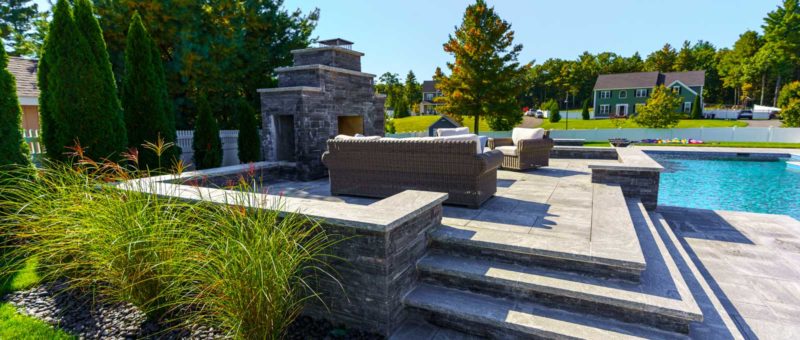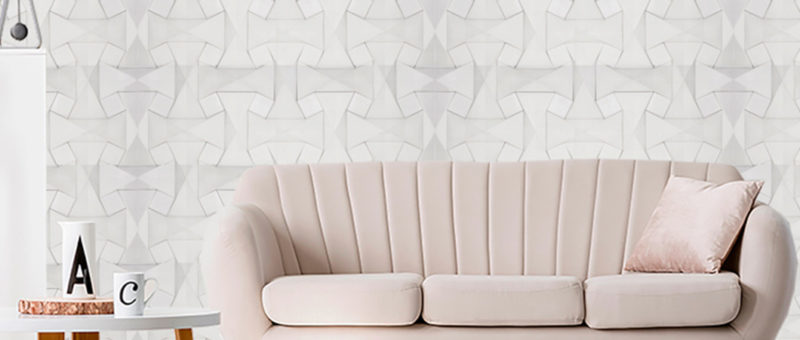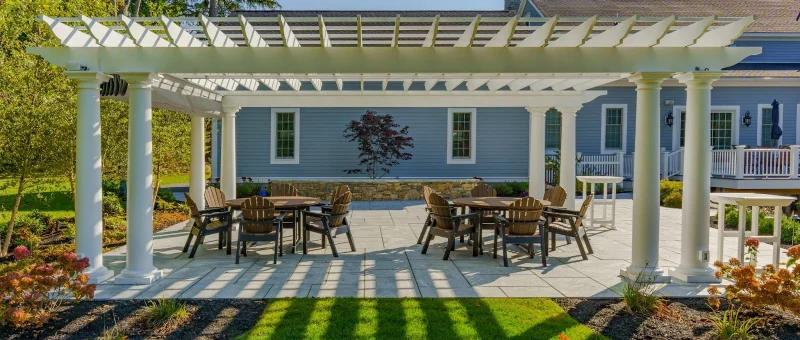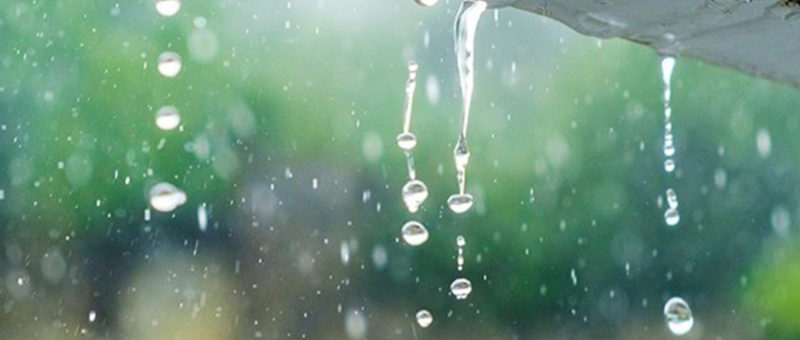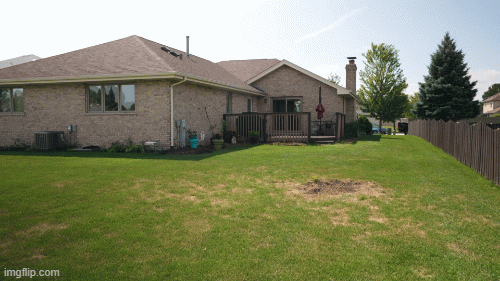
The Homeowner’s Guide to Building a Backyard Oasis With Natural Stone
Published:
Last Updated:
Author:
Imagine stepping into your backyard and having everything you love right at your fingertips.
—a pool for cooling off, a fireplace for warming up, and an outdoor entertainment area for drinks and dinners. If you’re planning to create a backyard oasis, whether small or big, there are a few things you should keep in mind. We spoke with landscape designer Cysilia Schaub with The Concrete Service, Inc. to find out what you need to know before you start designing your backyard project.

Landscape Designer, Cysilia Schaub
What’s Your Vision for Your Backyard Oasis?
When you look out back, what do you want to see? Maybe it’s a pool for the kids and a patio dining area for you? Schaub suggests starting by living in your space for a little while to get a feel for how you might want to use it. Then make a wish list. Be sure to have all parties involved who will be using the space, such as both partners in a couple.
“If it’s just the wife doing the design, then the husband may come in and want something different. Then the designer has to do a lot of extra work going back and redoing the plan to accommodate them both, which can also push out the timeline.” Schaub says.
She suggests putting what you want in your wish list and your likes and dislikes. If you see something at a neighbor’s house or online, add it to the list to share with the designer. “That way I can make sure to start steering them in the right direction,” says Schaub.
If you need some more direction when it comes to the design process from inspiration to finalizing a design for a contractor, Tilly Design is a great resource for helping you create a custom landscape design.
Timing Is Everything
Being aware of timing is also important. Schaub says many homeowners want to start a backyard project as soon as the warm spring weather hits. But then they face the reality of waiting for materials, available contractors or the project taking longer than they imagined. She says it’s a good idea to start planning a year to six months in advance. “If you only give your contractor a couple of months to come up with the design, figure out a budget and get everything mobilized, chances are it’s not going to happen. If you want a project for next summer, start planning this summer.”
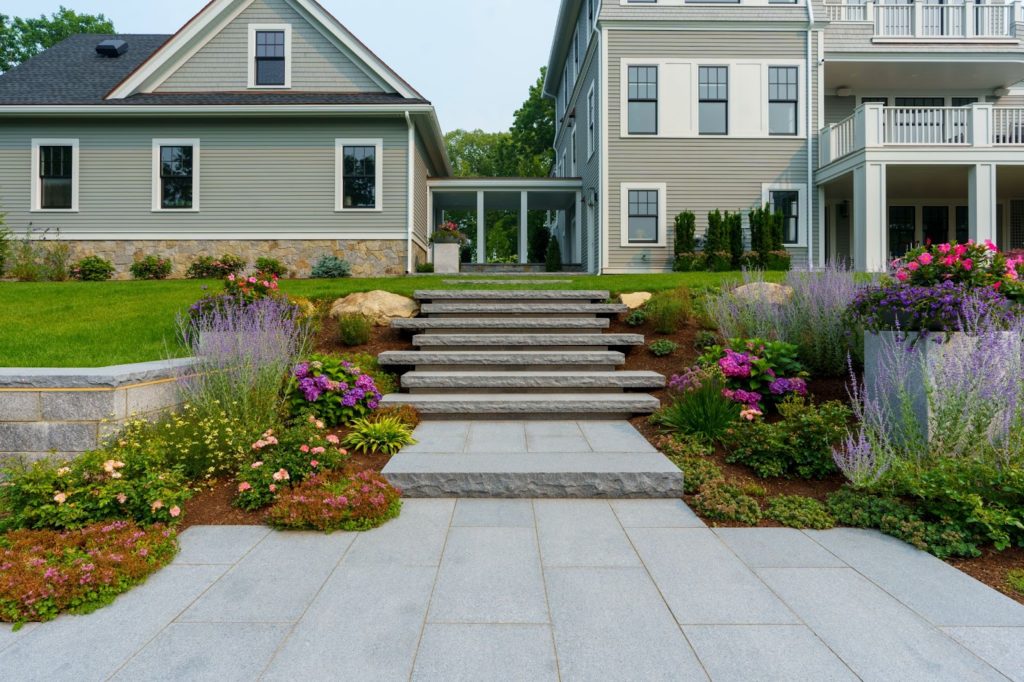
Start By Contacting a Reputable Landscape Designer or Architect
As a homeowner, it may be daunting to know whom to call to start a backyard project. A little industry insight: A landscape designer can create a backyard project based on their experience and knowledge. They may not be formally educated in the trade or have a degree in a related skill. A landscape architect may have a higher education in engineering or civil architecture. Some design-build firms are both design and install, and have a collection of landscape designers and builders who work for them and can complete a project from beginning to end. Some designers work independently to design a project and then can recommend contractors to do the work.
Schaub says finding the right people is really important. Not only are you making a major investment in your home, and you want the work to be done well, but you also have to work—and live—with these people around your home potentially for months. “You’re going to have to look at and be with them every day,” she says. “You want to trust them and get along with them.”
Be sure to take the time to research them and meet them. Look at their portfolio, understand their experience. Get a sense of how they work and their capability of handling your project so you both feel comfortable going in.
The Onsite Walk-Through to the Design
Your landscape professional will first want to do a walk-through of your property and discuss what you want to do. Keep in mind that functionality is a priority over aesthetics. Your intended use of the area must be established. Then you can make it pretty. Once the designer understands your vision, they will create a design for you to approve or ask for revisions. Schaub says it’s worth including a building contractor in the discussions to note any challenges to technical aspects of the installation and to make sure the design is within budget.
Natural Stone vs. Manufactured Stone or Concrete
Schaub notes that a big part of the budget will be determined by the cost of the materials, followed by the labor cost. When your design is getting to the final stage, your designer will likely bring you samples from a company like Instone for you to select the stone style you want. While natural stone such as Aura Natural Landscapes may be a bit more expensive than manufactured stone, Schaub recommends it because the benefits outweigh the cost. “A big benefit is the aesthetic. The color and movement of natural stone just looks so much better,” she says. “Concrete products are made to mimic natural stone and some do it well, others don’t.”
She adds that the durability of natural stone also can’t be beaten. It’s stain resistant, scratch resistant and fade resistant. It’s been on earth for millions of years and can withstand the elements. While some concrete products try to include these benefits, Schaub cautions, “By the time you’re getting into the price range of a concrete product that has all of these features, it’s pretty close to the price of natural stone. So it’s pretty easy to make that jump and just go with natural stone.”
Here are some selections of Aura Natural Landscapes:

Benefits of Using Aura Natural Landscapes
Schaub says she’s now worked with Aura Natural Landscapes for several projects. She says what she likes about it is how consistent the product is. “The colors and thickness of the stone are exactly what you’re expecting, which is really important from an install standpoint.”
She says the availability is also better than other products meaning short lead times. “It’s not uncommon to have to wait three months for materials. But with Aura, I can usually get it within a couple of weeks. And their customer service is great. I’ve had questions about how to manipulate the product, and they are quick to respond.”
What Can You Put in Your Backyard?
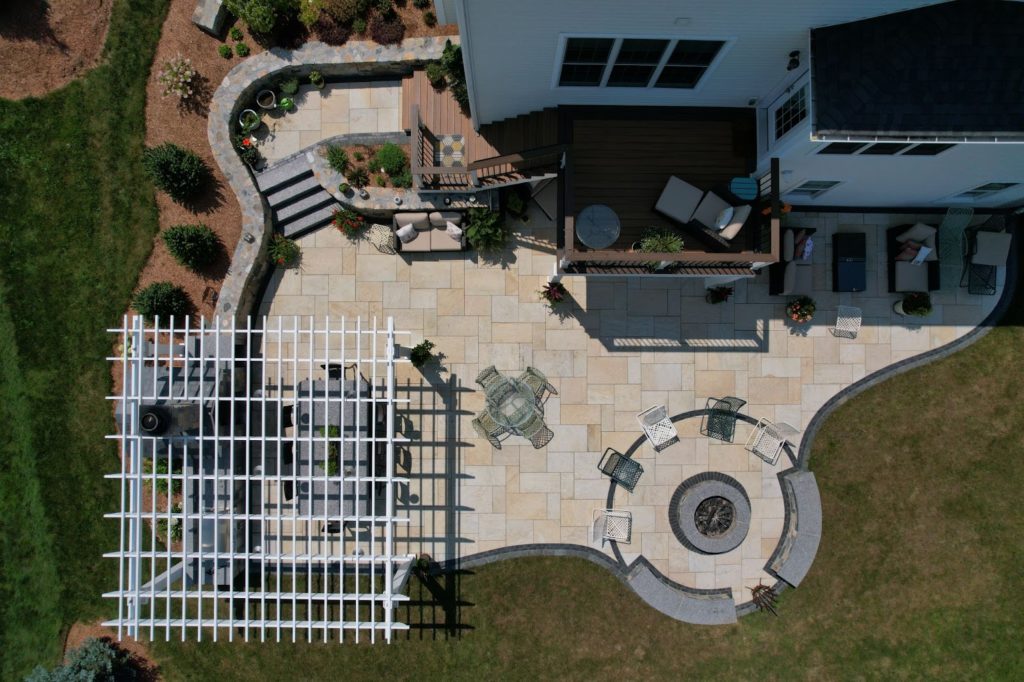
Some options to consider when setting up your backyard oasis include:
Features:
- Outdoor kitchen/bar
- Pool
- Patio
- Garden
- Sitting area
- Fireplace
- Fire pit
- Water feature (fountain, waterfall)
Design Style:
- Formal
- Informal
- Modern/Contemporary
- Woodland/Natural/Rustic
While it’s easy to want everything, and improving your backyard space will bring a higher return on your home’s value, it’s better to start small than go overboard. You want to make sure you’re going to use everything you put in. A simple design may also be more attractive if you want to sell your home later on to someone who will like what you’ve done rather than someone who may want to rip out an overdone backyard. And remember, the more complex the project, the longer the installation will take.
Other Considerations for Your Backyard Oasis
Schaub says you also want to consider what is already in your backyard. Is there a view you want to take advantage of? Are there slopes that need to be accommodated with steps and proper water drainage? Are there mature trees with large roots? Your designer will help you work around challenges and take advantage of the natural beauty of your property.
Also, note what permits you may need to do building work. These can range from county soil and erosion permits, building permits and permits if your property is on an inland lake or stream. Check your local township and state requirements for what’s needed. In addition, check what setbacks you have to follow for your particular property. Your landscape designer should be able to help you find out what permits you need for your specific design.
So if you’re thinking about a backyard makeover, the time to start planning is now. Make your wish list and contact us for samples of Aura Natural Landscaping products!


